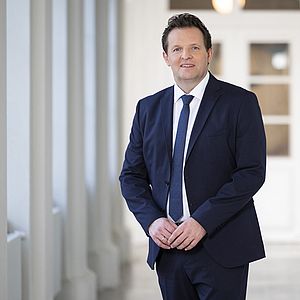From democracy to dictatorship
Just how fragile democracy is was shown by political developments in the First Republic. Crises and radicalisation disrupted everyday political life. The crash of the New York Stock Exchange in October 1929 set off a chain reaction. Mass unemployment and social deprivation fuelled recriminations against the democratic state. Against the backdrop of the Great Depression, authoritarian currents gathered strength. The yearning for leaders with quick solutions grew.
Austria’s democracy collapsed in 1933. Under Federal Chancellor Engelbert Dollfuss, the Christian Social Party established the Ständestaat dictatorship. The Social Democrats were crushed in the failed uprising of February 1934. But the authoritarian corporative state failed to convince enough people of the merits of the Austrian solution. The National Socialist movement gained momentum in the underground. The Nazis’ seizure of Austria in March 1938 met with no resistance. The majority of Austrians gave the invading German troops an enthusiastic welcome. Hitler visited Innsbruck one month later and was given a euphoric reception by the Tyroleans.
Crises an radicalisation
1. Radical and antisemitic election poster for the 1920 national elections, ÖNB
2. Demonstration in favour of union with Germany on Maria-Theresien-Strasse, April 1921, StAI
3. Parade of the National Socialists with Gauleiter Franz Hofer on Maria-Theresien-Strasse, May 1933, StAI
4. Nazi demonstrators disrupting a parade of the Heimatwehr, the paramilitary arm of the Christian Social Party, in Innsbruck, StAI
5. Leaflet issued by the Christlicher Mittelstand in 1889
1. Confrontation instead of compromise
The political differences between the two major parties were fuelled by enmity and hatred. Violence replaced a willingness to compromise.
2. “Back home to the Reich”, 1921
Apart from hunger, inflation and mass unemployment, the First Republic had nothing to offer the Austrian population. Most Tyroleans were in favour of union with Germany.
3./4. The rise of the NSDAP
The National Socialist movement profited most from the crisis, offering radical solutions to the problems of the time. Within a few years, it rose from insignificance to become a mass movement. Violence increasingly dominated conflicts with political opponents.
5. Antisemitism as a simple solution
The National Socialists offered a simple solution to the problems of the time: antisemitic agitation. They made the Jews the scapegoat for the crises. Anti-Jewish attitudes were deeply rooted in Austrian society. Antisemitism had long been used as a political tool.
Ständestaat dictatorship
1. From left to right: Heimatwehr leader Richard Steidle, Bishop Sigmund Waitz, Federal Chancellor Engelbert Dollfuss and Governor Franz Stumpf at a demonstration in Innsbruck, June 1933, StAI
2. Oath of office of the caretaker Georg Frauscher, May 1933, TLA (excerpt)
3. Poster of the Fatherland Front, the ruling political organisation of the Ständestaat dictatorship, 1934, StAI
4. 17-year-old student Walter Lunger, an innocent bystander, lost his right hand as a result of a Nazi bomb blast, StAI
5. Gauleiter Franz Hofer after his escape, during which he was wounded, at the Reich Party Congress of the NSDAP in Nuremberg, September 1933, BSB Munich
6. Memorial poster for Engelbert Dollfuss, who was murdered by the Nazis, StAI
1./2./3. “So help me God”
The Ständestaat dictatorship (Ständestaat = corporative state) had the backing of the Christian Social Party, the Catholic Church and the paramilitary Heimatwehr. Foreign policy was modelled on that of fascist Italy. With the exception of the Fatherland Front, all political parties were banned. The new oath of service was sworn to “God Almighty".
4./5./6. Nazi terror, prohibition of the NSDAP, July Putsch 1934
The Nazi movement responded to the Ständestaat dictatorship with acts of terror. Following a spate of attacks in 1933, the NSDAP was banned. More than 600 Tyrolean National Socialists fled to Germany. Gauleiter Franz Hofer was captured but managed to escape. In July 1934, the National Socialists launched an attempted coup. The putsch failed. Dollfuss was assassinated and the cult of the “heroic chancellor” created.
Taking possession
1. In Innsbruck on 9 March 1938, Kurt Schuschnigg announced a referendum on Austrian independence, StAI
2. Poster for the announced referendum, StAI
3. National Socialist demonstration in Innsbruck on 10 March 1938 against the announced referendum, StAI
4. Egon Denz, later Lord Mayor of Innsbruck, informed the crowd about the latest developments from the window of the Alt-Innsprugg inn on 11 March 1938, private archive of Michael Gehler
5. Swastika flag on the Landhaus on the evening of 11 March 1938, StAI
1./2./3. “This referendum – a scandal”
In Innsbruck on 9 March 1938, Kurt Schuschnigg, successor to the assassinated Federal Chancellor Dollfuss, announced a referendum. He wanted the Austrians to say whether they were in favour of “a free and German, independent and social, Christian and united Austria”. The next day, 10 March 1938, the Nazi party held a demonstration against the referendum in the streets of Innsbruck.
4./5. There must be no resistance
Josef Schumacher, Governor of Tyrol, left his office in the Landhaus at around 7 p.m. His secretary later phoned him with the news that the crowd wanted “the swastika flag hoisted on the Landhaus”. Schumacher gave orders that there should be no resistance. An hour later, a Nazi flag was hanging from the Landhaus. The National Socialists took possession of the Landhaus as the first public building.
Hitler’s visit to Innsbruck
1. Gauleiter Edmund Christoph welcoming Adolf Hitler in the chamber of the Tyrolean Parliament on 5 April 1938, BSB Munich
2. The local Nazi elite and Adolf Hitler in the chamber of the Tyrolean Parliament on 5 April 1938, private archive of Michael Gehler
3. Propaganda photos of Adolf Hitler’s visit to Innsbruck in April 1938 taken by Heinrich Hoffmann, Hitler’s personal photographer, BSB Munich
4. Amateur film of unknown origin showing Adolf Hitler’s visit to Innsbruck in April 1938, StAI
5. Jewish shop daubed on the occasion of Adolf Hitler’s visit to Innsbruck in April 1938, StAI
6. Propaganda in the “Innsbrucker Nachrichten” for Adolf Hitler’s visit to Innsbruck in April 1938, ANNO/ÖNB
1./2. “In thrall of the becoming of a people”
Hitler visited Innsbruck as part of the propaganda campaign for a referendum to retroactively validate the Nazi annexation of Austria. The climax of his visit was an event in the Landhaus.
3. The power of the packaging
Within a very short space of time, the National Socialists managed to win over the majority of the population. In their propaganda, the Nazis made skilful use of the existing enthusiasm in Austria. They were very much aware of the power of the packaging. Nothing was left to chance.
4. Unfiltered images
For the Nazi propaganda, a close watch was kept on all that was published. Private footage, however, provides glimpses of the realities beyond the controlled media landscape. The colour film, presumably made by a Nazi official, contains unfiltered images of Hitler’s visit.
5. From discrimination to mass murder
A majority accepted or approved of the inhumane policies of the Nazi movement. Economic discrimination was followed by the mass murder of over 6 million Jews by the Nazis.
6. The visit of the Führer in Nazi propaganda
There was no other topic in the newspapers for days. They sought to alert the population to a “turning point” in their lives. Their welcome for the Führer was a welcome from a Tyrol as a “bastion of National Socialism” combining “an ardent love with an insatiable willingness to fight”.








